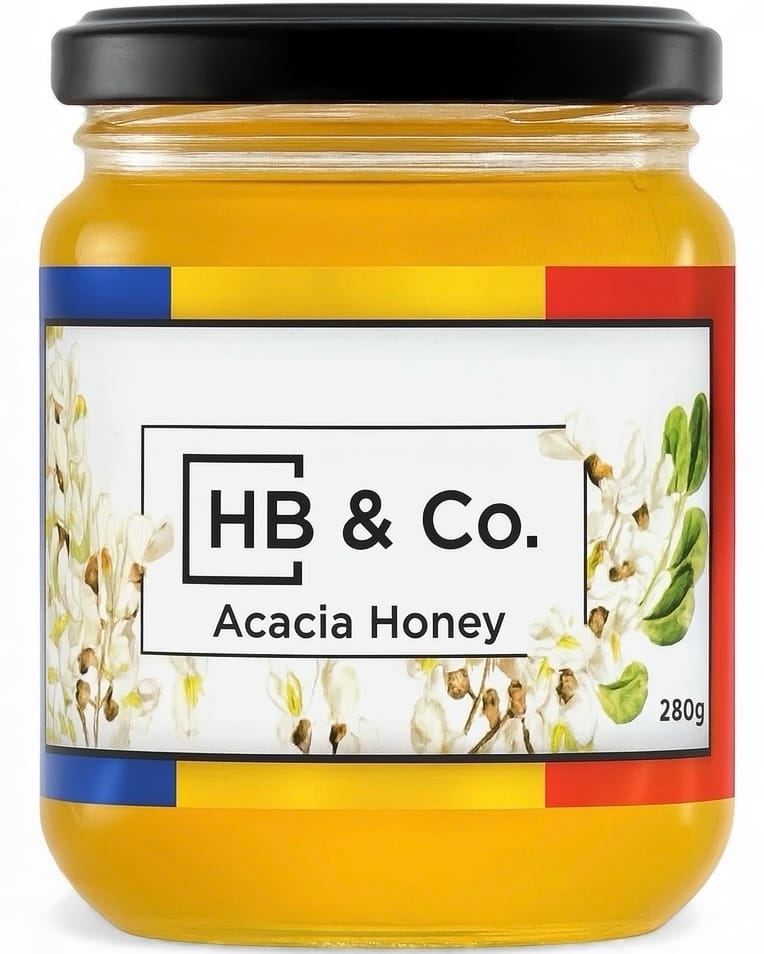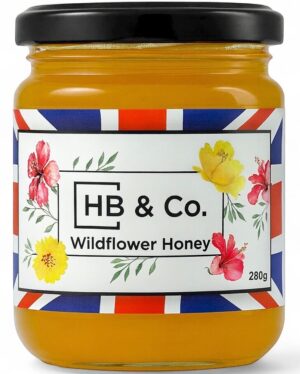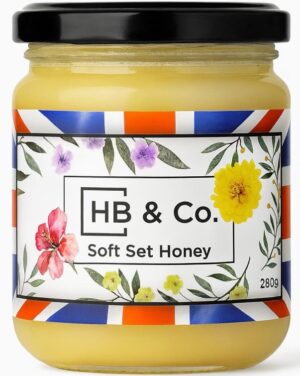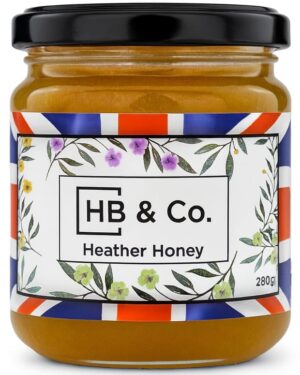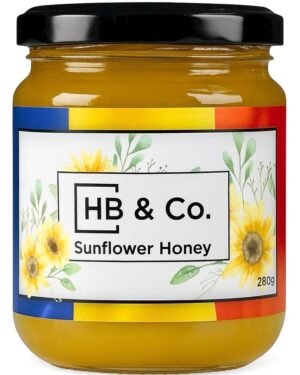Acacia Honey
Acacia Honey
One of the clearest honey you will ever see, our 100% Pure Acacia Honey is both light and luxurious in taste. It’s raw, cold extracted and cold filtered, resulting in a more naturally fragrant finish.
Acacia is one of the few honeys that takes more than a year to crystallize as the nectar of the acacia flower is jam packed with natural fructose. Perfect for adding light, floral sweetness to teas, sumptuously spread over bread or generously poured into porridge.
100% Acacia Honey, net weight 280g
£10.99 — or subscribe and save 20%
Availability: In stock
Related products
Quality Testing Results
Honey Bee & co Acacia Honey Lot 1
Acidity: 0,91 ml NaOH 1 n/100g
Superior Quality Acacia Honey should have: Acidity: max. 4 ml NaOH 1n/100g
UK Law -Free acid - all honey except for baker’s honey, not more than 50 milli-equivalents acid/kg
The low pH of honey inhibits the presence and growth of microorganisms. Its low pH makes honey compatible with many food products in terms of pH and acidity. Acids are an important component of the flavour and aroma of monofloral honey.
Diastase = 13.9%
The honey-own enzyme "Diastase" (scientifically it concerns an α-Amylase) is a marker for the authenticity of honey and represents an important quality parameter.
Accordingly, the diastase number (DN) is legally regulated according to the Schade scale (EU regulation 2001/110/EG, Codex Alimentarius).
For honey with exception of baker’s honey / industrial honey a minimum activity of 8 DN (Schade scale) is fixed.
Moisture content = 18,44%
It is internationally recognized that good quality honey should be processed at less than 20% water content. Low water content is desirable because honey may begin to ferment and lose its fresh quality if the water-in-honey is greater than 20%
UK Law - Moisture content— (a)all honey except for honey specified in paragraph (b), (c) or (d) not more than 20%.
and I strongly recommend it. I will certainly be purchasing it again.
I was impressed when I saw it's a romanian product, as I am from Romania.
Good to boost my immunity.
Thank you very much.
Stelian
Product Overview
Pure Acacia Honey by HoneyBee & Co. is a smooth, delicate honey known for its clear golden hue and subtle floral aroma. Naturally low in pollen and slow to crystallise, it remains beautifully liquid for months. Perfect for drizzling over porridge, blending into tea, or sweetening yoghurt, it’s the ideal choice for those who love a gentle, refined sweetness.
Why Acacia Honey?
Acacia Honey is often called “liquid gold” for its clarity and mild taste. It’s rich in natural antioxidants and enzymes that support digestion and energy balance. Acacia honey is also rich in powerful plant compounds like flavonoids that act as antioxidants, further enhancing its health benefits. A diet high in flavonoids may reduce the risk of chronic conditions, including heart disease and certain types of cancer. Its high fructose content keeps it liquid longer, making it one of the most versatile honeys for daily use. Acacia honey is also lower in glucose compared to other honeys, which contributes to its unique nutritional profile and slower crystallization. Acacia honey is safe to eat for most people and can be enjoyed as part of a healthy diet. However, it is recommended that certain populations, such as infants under the age of one, avoid consuming honey due to potential health risks.
From Hive to Jar
The acacia honey comes from our family hives allowing us to guarantee our commitment to sustainability and purity. Each jar is filled with raw, unprocessed honey never pasteurised, never blended. Our Acacia Honey is harvested from the blossoms of Robinia pseudoacacia trees, carefully filtered, and jarred with minimal handling to preserve all beneficial enzymes and nutrients. Each jar is individually wrapped or sealed to maintain freshness and quality during storage and delivery. The finished honey is stored in hexagonal wax cells, and once the moisture content is low enough, bees cap the cells with beeswax, ensuring its quality and longevity.
Ways to Enjoy It
✔️ Drizzle over Greek yoghurt or pancakes
✔️ Stir into herbal teas or warm lemon water
✔️ Pair with mild cheeses like ricotta or brie
✔️ Add to salad dressings or glazes for natural sweetness

Acacia Honey Benefits
Acacia honey’s mild taste makes it a versatile choice for different foods and snacks. For example, it can be added to yoghurt, cereal, or ice cream without overpowering other flavours. Additionally, because acacia honey is low in acid, it pairs exceptionally well with many cheeses, from mild to strong varieties. Its delicate, floral sweetness enhances cheese tasting experiences and is suitable for serving alongside different types of cheeses, as well as fruits and nuts like figs, apricots, and other types of fruits and nuts. Acacia honey also pairs beautifully with apples and nuts, making it a delightful addition to any cheese board or snack platter. As far as baking is concerned, acacia honey can be a good choice in certain situations. It is pretty sweet because of its high fructose content, making it an excellent option as a sweetener.
Acacia is one of the few kinds of honey that takes more than a year to crystallize as the nectar of the acacia flower is jam-packed with natural fructose. The appearance of acacia honey can vary, but it is often described as very light, pale, or even transparent, especially when raw. Its crystal-clear color and clean, mild sweetness make it well-loved around the world. Perfect for adding light, floral sweetness to teas, sumptuously spread over bread or generously poured into porridge.
Raw Acacia Honey can benefit digestion and it can help clean the liver. Helps to restore the body after effort. Stimulates the immune system. The number of red blood cells increases. Acacia honey contains many beneficial elements including up to 415 different enzymes and vitamins. Additionally, acacia honey can soothe sore throats and coughs due to its smooth texture.

When you go into the store to buy wine, you can't just grab any old bottle off the shelf; there's an enormous selection of different kinds, each with its own distinct flavour.
In the same way, buying honey shouldn't be as simple as going to the supermarket and picking up a jar; there are over 300 varieties of honey, each with different colours, aromas, tastes and benefits. Many of the jars labelled "honey" actually contain a product that has been so heavily processed or altered with artificial sweeteners that it has lost most of the nutrients and health benefits of raw honey.
The name acacia honey might make you think of African plains or Hawaii, but acacia is most commonly found in Australia. The plant is native to the southeastern United States but can now be found in North America, Europe, Asia, and Africa. And more importantly, acacia honey does not come from any of these trees. Black acacia, or "false acacia", usually from the species Robinia pseudoacacia or Caragana arborescens, is where acacia honey comes from.
The source of the honey determines its colour. "False acacia" produces honey that is white or pale yellow. There are more than 300 varieties of honey being commercialised, each with its own distinct colour, aroma, taste and range of health benefits.
False Acacia, is a genus of shrubs or small trees of the pea family Fabaceae and the subfamily Mimosoideae. The species are native to Australia, New Zealand and some countries of the South Pacific region, growing in subtropical and tropical climates. The leaves of False Acacia plants are bipinnate, and in some species, also tripinnate or even quadripinnate. The flowers have both male and female parts and are wind pollinated. False Acacia plants produce large numbers of pods which contain numerous seeds.
Characteristics of Raw Honey
Raw honey, especially raw acacia honey, is cherished for its purity and the way it preserves all the natural goodness straight from the hive. Unlike supermarket honey, which is often pasteurised and filtered, raw honey is harvested with minimal processing, ensuring that its natural enzymes, vitamins, and minerals remain intact. This means you get a sweetener that’s not only delicious but also packed with health benefits. While darker varieties of honey, such as buckwheat honey, are known for their strong, earthy, and medicinal tastes, acacia honey stands out for its milder and more delicate flavour.
One of the standout features of raw acacia honey is its delicate flavour and lovely sweetness, which comes from the nectar of the false acacia tree, also known as the black locust or Robinia pseudoacacia flower. This gives the honey a mild, floral taste that’s lighter than many other honeys, making it a favourite for those who appreciate a gentle, refined sweetness. The best acacia honey is often described as having a rich yet subtle aroma, with hints of flowers and fruits that make every spoonful a delight.
Nutritionally, raw honey is a powerhouse. It boasts a low glycemic index, so it won’t cause sharp spikes in blood sugar like refined sugar does. This makes it a smart choice for anyone looking to manage their sugar intake without sacrificing taste. Raw acacia honey is also rich in antioxidants such as beta carotene and vitamin C, which help protect the body from oxidative stress and support overall health. Additionally, acacia honey contains beneficial minerals such as magnesium, potassium, and iron, which contribute to its nourishing profile. Its natural antibacterial properties, due to components that produce and slowly release hydrogen peroxide, can soothe sore throats and even help with skin irritations, while the presence of minerals and vitamins adds to its nourishing profile. Furthermore, acacia honey may aid in wound healing by helping to prevent bacterial contamination and infection.
The thick, luscious texture of raw honey makes it perfect for drizzling over porridge, spreading on toast, or stirring into your morning coffee or tea. Use a spoon to drizzle or mix acacia honey into recipes or directly onto foods for easy serving. Acacia honey can be drizzled over Greek yogurt, fruit, or oatmeal, adding a touch of natural sweetness to your meals. Its mild, sweet flavour enhances everything from fruits and nuts especially apples to baked goods and preserves, adding a touch of lovely sweetness without overpowering other ingredients. Whether you’re using it in cooking, baking, or simply enjoying it by the spoonful, raw acacia honey brings a wonderful, natural richness to your favourite foods and drinks. For a creative twist, try mixing acacia honey into smoothies or dressings for added sweetness.
When it comes to choosing the right honey, quality matters. Look for organic acacia honey or raw acacia honey that’s been produced sustainably and is free from additives or artificial ingredients. Shopping at a trusted shop or online store specialising in lovely honey ensures you’re getting a product that’s as close to nature as possible. By making the switch to raw honey, you’re not only treating yourself to a delicious, natural sweetener but also supporting your health and the environment—one lovely jar at a time.
Nutrition and Properties
Raw acacia honey is more than just a sweet treat it’s a nutrient-rich powerhouse that brings a host of health benefits to your table. Thanks to its high concentration of antioxidants like flavonoids and beta carotene, this honey helps shield your body from free radicals and oxidative stress, supporting overall health and vitality. Rich in essential vitamins and minerals, including vitamin C, raw acacia honey offers a gentle boost to your immune system and contributes to your daily intake of nutrients.
One of the standout features of raw acacia honey is its low glycemic index, making it a smart alternative to refined sugar for those looking to manage their blood sugar levels without sacrificing sweetness. Its delicate flavour and light, almost transparent appearance make it a lovely addition to a wide variety of foods and drinks. The low acid content of this honey means it pairs beautifully with many cheeses, fruits, and nuts, enhancing their natural flavours without overpowering them. Whether you’re drizzling it over fresh fruits, stirring it into drinks, or enjoying it with your favourite cheeses, raw acacia honey delivers a rich, delicate taste that’s both delicious and nourishing. With every spoonful, you’re treating your body to a blend of vitamins, minerals, and antioxidants that support your health in the most delightful way.
Skincare Benefits
Raw acacia honey isn’t just a treat for your taste buds it’s also a gentle, natural ally for your skin. Thanks to its powerful antibacterial properties and high antioxidant content, this honey can help keep your skin clear and healthy. It’s a popular natural remedy for acne, as it helps reduce inflammation and prevent the growth of bacteria that can cause breakouts. The gentle nature of raw acacia honey makes it suitable for even the most sensitive skin, soothing redness and irritation with every application.
As a natural humectant, raw acacia honey draws moisture into the skin, leaving it feeling soft, supple, and hydrated. Incorporating this honey into your skincare routine can help promote a healthy, glowing complexion and may even reduce the appearance of fine lines and wrinkles over time. Whether used as a face mask, spot treatment, or soothing addition to your favourite skincare products, raw acacia honey brings the goodness of nature straight to your skin, helping you look and feel your best.
Uses in Daily Life
Raw acacia honey is a fantastic addition to your daily routine, offering both versatility and a host of health benefits. Its delicate flavour makes it the perfect sweetener for tea, coffee, or porridge, adding a touch of natural sweetness without overpowering your favourite drinks and dishes. Spread it on toast, swirl it into yoghurt, or drizzle it over oatmeal for a rich, delicious start to your morning.
In the kitchen, raw acacia honey shines as a natural ingredient for cooking and baking, infusing recipes with its unique, delicate flavour. Its high fructose content provides a quick and sustained energy boost, making it a great choice for a natural pick-me-up during busy days. Raw acacia honey is also a soothing remedy for sore throats, helping to calm and comfort with every spoonful. With so many ways to enjoy it, from sweetening drinks to enhancing your favourite recipes, raw acacia honey is a truly fantastic staple for anyone who values both flavour and health.
Storage and Handling
To ensure you enjoy the full health benefits and delicious taste of raw acacia honey, proper storage and handling are key. Always keep your honey in a cool, dry place, away from direct sunlight and sources of heat, to preserve its quality and natural properties. Because honey can easily absorb odours, store it away from strong-smelling foods to maintain its pure, delicate flavour.
Opt for recyclable packaging, such as glass jars, to help protect the environment while keeping your honey fresh. When serving raw acacia honey, use clean, dry utensils to prevent contamination and preserve its raw goodness. By following these simple tips, you can enjoy the rich, lovely taste and health benefits of raw acacia honey for months to come, knowing you’re making a choice that’s good for both your body and the planet.
Certifications and Quality
When it comes to choosing the best acacia honey, certifications and quality standards make all the difference. Our raw acacia honey is proudly certified organic, which means every jar is free from refined sugar, artificial additives, and any unwanted chemicals. This organic acacia honey is harvested from the nectar of the Robinia pseudoacacia flower also known as the false acacia tree or black locust ensuring a delicate flavour and lovely sweetness that sets it apart from supermarket honey and other honeys.
We believe that lovely honey should be as pure and natural as possible. That’s why our raw acacia honey is packed with natural enzymes, antioxidants, and essential vitamins like vitamin C, all of which contribute to its impressive health benefits. With a low glycemic index and low acid content, it’s a delicious and gentle alternative to refined sugar, making it a favourite for those who want to enjoy sweetness without compromise.
Our commitment to quality extends beyond the honey itself. Each batch is carefully packaged in recyclable packaging, so you can enjoy your favourite honey while caring for the environment. We offer reliable delivery options, including scheduled and regional delivery services, to ensure your order arrives conveniently and on time. Our dedicated customer service team is always available to assist you, providing support and making the entire process smooth and hassle-free. The antibacterial properties and rich, delicate flavour of our raw acacia honey make it a wonderful addition to tea, toast, drinks, or any recipe that calls for a touch of natural goodness.
From the moment the bees collect nectar from the black locust blossoms to the time you open your jar, every step is handled with care to preserve the honey’s natural enzymes and lovely taste. Whether you’re looking to enhance your morning routine or searching for a healthy, raw sweetener, our organic acacia honey delivers quality you can trust.
Don’t wait! Purchase your jar today and discover why so many consider it the best acacia honey for both flavour and health.
Your Questions Answered
No. Honey Bee & co Honey is Raw Honey. Exactly how bees have made it.
No. Our Acacia Honey is produced in pure and uncontaminated natural areas and our bees are not treated with antibiotics.
Our Acacia Honey contains an Optimal water percentage between 15% and 19%. Cheap supermarket honey can have up to 50% water. This is due to either beekeeper feeding bees water with artificial sugar or they collect the honey to quickly to increase profit margins.
Nectar is a liquid secretion of flowers that bees gather. They then take out much of its water content and after adding several enzymes they produce the golden substance we call honey.
Consuming honey rather than sugar has obvious advantages. The supply to the body of energy in the form of glucose and fructose, simple sugars that do not require any digestive process. Honey also contains Vitamins and other useful enzymes.
Raw Honey is a product with many calories; approximately 320 kcal for 100g. Moderation is the key if one has a particular diet. The positive fact about honey is its sweetness. One teaspoon of honey weighs about 7g and its more than enough to sweeten your favourite cup of tea.
Raw Honey is safe and it provides many health benefits, nevertheless, it should not be cooked raw over 40 degrees. When cooked, honey becomes similar to glue and thus produces toxins. Honey's raw form is the one detaining all its main benefits and properties. By altering its chemical composition by heating or overheating the honey It may completely change its compounds leading to health hazards. Honey also contains bacteria that can harm a young baby’s intestine. To this end avoid giving honey to babies under 12 months old.
Our bees are from the Apis Mellifera from the Apidae family.
Our honey is produced on the European Continent. Our long-term goal is to partner with small beekeepers from all over the UK and Europe providing our customers with quality honey while helping increase the European bee population.
Acacia Honey Stimulates digestion cleans the liver, regulates intestinal transit. Improves heart activity and circulatory system. Helps to restore the body after effort. Stimulates the immune system. The number of red blood cells increases.
Honey is a healthier alternative to sugar, especially for diabetics. It has antioxidants that help reduce the risk of heart attacks, strokes, and some types of cancer. It lowers blood pressure and improves cholesterol values. Honey is great for healing wounds and burns.
Honey is a great solution for coughs both for children and adults.

